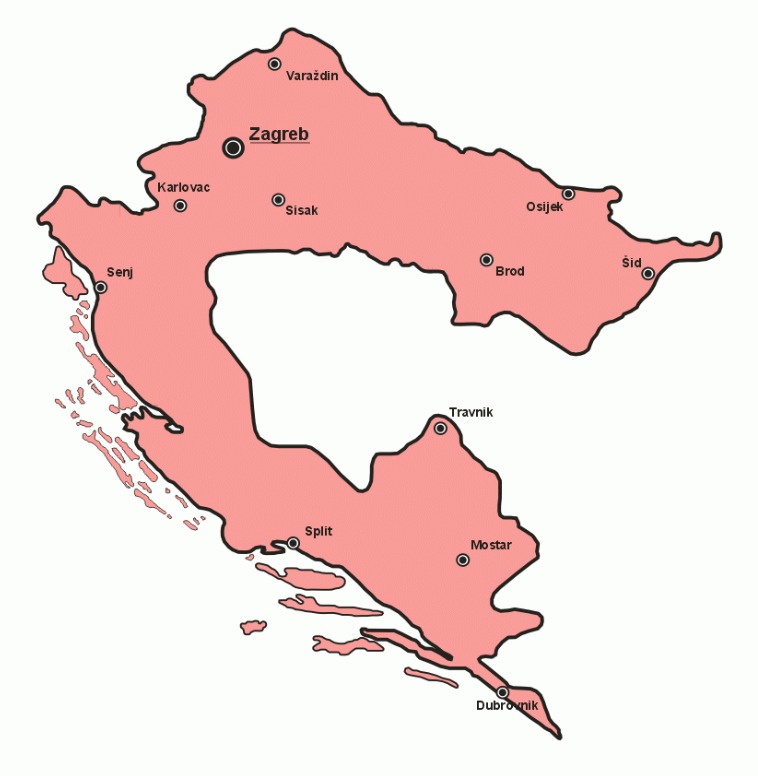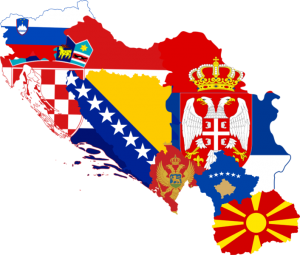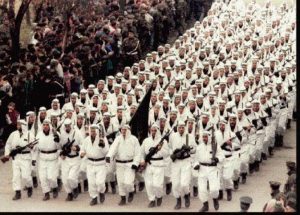
Views: 1635
The Croatian (Illyrian) Revival Movement until a victory of the national (South Slavic) language (1847)
The Austrian Emperor, Ferdinand V (1835–1848), on January 11th, 1843 issued the order of prohibition of the use of the Illyrian name and the Illyrian coat of arms. The prohibition was officially justified with the explanation that such a measure was necessary for the purpose to restrain further political struggle and attacks from the Illyrian Party against the mađaroni and the ethnic Hungarians in Croatia-Slavonia. At the same time, the Ottoman authorities required from the Habsburg Emperor to forbid the public use of the Illyrian name and to dissolute the Illyrian Party with an explanation that the Croat ilirci were preparing a Christian uprising in the Ottoman province of Bosnia-Herzegovina (the Pashalik of Bosnia) against the Ottoman central Government for the purpose to separate this province from the Ottoman Empire and to include it into the united (Greater) Croatia within the Austrian Empire.
In the new political conditions, the leaders of the Illyrian Party in order to continue their legal and public political struggle against the mađaroni decided to change the party-name into the People’s Party. However, after 1843, the Illyrian name was gradually more and more replaced by the Croat national name. Before that time, a Croat ethnic name was used only in a part of the present-day (Greater) Croatia where the kajkavian dialect was spoken. However, after 1843 the Croat ethnic name was more and more spreading itself in Slavonia, Dalmatia and parts of Bosnia-Herzegovina where the čakavian and the štokavian dialects were spoken by the South Slavic Roman Catholics who used the Latin alphabet. In the course of time, their national name became the Croat one.[1] Further, the leadership of the Illyrian Party decided to change the name of its own newspaper into the Narodne novine (the People’s Newspaper), which are still printed today under the same name as an official herald of the Republic of Croatia.[2] However, this newspaper became once again renamed on March 20th, 1844 into the Novine horvatsko-slavonsko-dalmatinske (the Croatian-Slavonian-Dalmatian Newspaper), likewise its journal into the Danica horvatska, slavonska i dalmatinska (the Croatian-Slavonian-Dalmatian Morning Star).
One of the most crucial moments in deterioration of the Croatian-Hungarian relations occurred on May 2nd, 1843 when in the Croatian-Slavonian Sabor was given the first deputy’s speech in the South Slavic language by Ivan Kukuljević who required that a Croat national language should become an official language in Croatia-Slavonia. This requirement was pointed out against a linguistic Magyarization of Croatia-Slavonia. The same purpose had requirements by the Croatian-Slavonian representatives in the Hungarian Dieta in Bratislava in 1843 and 1844 to speak in Dieta in the Latin language, but not in the Hungarian. However, their requirement after a long discussion was rejected by the Hungarian deputies in Dieta, which became the crucial reason for the Croatian-Slavonian representatives to boycott the further sessions of the assembly. Nevertheless, when they left the Dieta, the same assembly decided that the Hungarian language had to be introduced in Croatia-Slavonia within the period of next ten years as the only official language. Nevertheless, this decision was not recognized by the Hungarian King (who was at the same time and the Austrian Emperor) and, therefore, did not receive the legal royal confirmation.[3]
The year 1844 is of threefold importance for both the movement and Croat national politics:
- The Illyrian Movement, now under the new name, achieved great political-national success in Dalmatia in 1844 when the newspaper Zora dalmatinska (the Dalmatian Dawn) started to be published in the city of Zadar/Zara. Its editor and publisher, Ante Kuzmanić, chose ikavian sub-dialect of the štokavian dialect, for the language of his newspaper, but not ijekavian sub-dialect in which the Serbian literal journal in Dalmatia was published already from 1838 in the city of Zadar under the title Србско-далматински магазин (Serbian-Dalmatian Magazine) edited by Božidar Petranović. In fact, Ante Kuzmanić recognized the ijekavian sub-dialect of the štokavian dialect as solely Serbian national language (in which the best examples of Ragusian literature from the mid-15th century was written), while the ikavian he considered as the national language of the Croats. Nonetheless, publishing of Zora dalmatinska marked a beginning of spreading of the ideas of the Illyrian Movement in Dalmatia and later on of the Croat national ideology in this multiethnic, multilingual and multiconfessional province populated by the Croats, Serbs, and Italians.[4]
- In the same year (1844) it took place another important cultural event in Croatia in regard to the spreading out of the Croat national consciousness among the South Slavic Roman Catholics of the štokavian In the other words, at that year the Matica hrvatska, a supreme cultural institution of the Croat national revival movement, published the master-piece of the Ragusian epic Baroque literature – the Osman by Ivan (Dživo) Gundulić (1589–1638) with comments written by Ivan Mažuranić. This epic work was published in the original language in which it was written – ijekavian sub-dialect of the štokavian dialect. Subsequently, the leaders of the movement emphasized the “Croat” national character of the Ragusian history and culture that was immediately severely criticized by the Serb intellectuals and the public workers.[5]
- Finally, the political program of the movement was published as well as in 1844 by Bogoslav Šulek (a Croatized Slovak), in the booklet under the headline Što namĕravaju Iliri? (What do Illyrians Want?).
However, a previous imperial/royal decree upon the prohibition of the use of the Illyrian name was partially abolished on January 3rd, 1845 by the new imperial/royal order, according to which the Illyrian name could be used only in the literature, but not in the politics. The obvious change in the Austrian policy towards the Croats can be seen and from the fact that the Emperor allowed a foundation of the Department of the Illyrian language and literature at the Zagreb Academy.[6] At the same time, the censorship in Croatia-Slavonia was weakened. These changes in Croatia-Slavonia were closely connected with the new Austrian political course toward the Hungarians (Magyars) as the Habsburg Emperor intended to attract the Illyrians to the Austrian side in the German struggle against the ruling Hungarian Conservative Party in Pest and to make use of open clash between two political parties in Croatia-Slavonia: the mađaroni and the narodnjaci.
The most serious open clash between these two political groups in Croatia-Slavonia occurred on July 29th, 1845 in Zagreb. After the mađaron’s victory on the elections in Croatia-Slavonia, the fights on the streets between the members of these two parties took place and after the intervention of the army, they were transformed in the bloodshed. Thirteen people were murdered and 27 wounded. The local inhabitants were embittered and immediately the mađaroni and Ban Haller were accused to be the provocateurs of this bloody event. The funeral of the so-called Srpanjske žrtve (the July victims) became transformed into a peaceful demonstration against the violence, but also against the current political regime in Croatia-Slavonia.[7]
The Croat protesters required ecclesiastical, cultural and political independence for Croatia-Slavonia from Hungary. In other words, they required that a Croatian-Slavonian Archbishoprics will be established, likewise the national university and national independent government autonomous from Pest. Under the public pressure, a Croatia-Slavonia’s Ban Haller stepped back. A Hungarian outstanding political figure, Lajos Kossuth, accused the Croats of the high treason of the Hungarian state. These events from July 1845 became an introduction for the open war between the Croats (supported at that time by the Serbs) and the Hungarians during the time of the Hungarian Revolution and the War of Independence in 1848–1849.[8]
In the year 1846, the Illyrian Movement won the most important linguistic-political battle when the poem Smrt Smail-age Čengića, written by Ivan Mažuranić, was published in Zagreb in the štokavian dialect, which became soon accepted by the Croat intelligentsia as the literal language of all Croats. It is important to say that the author’s mother tongue was the čakavian but not štokavian dialect – a fact which was and is used by the Serbs as crucial evidence of the political Croatization of the Serb national language.
However, the poem Smrt Smail-age Čengića presented a victory of the aim of the leaders of the Illyrian Movement to promote exactly the štokavian dialect as the official literal language for all Croats.[9] In the same 1846 year, Petar Preradović published the Prvenci, Bogoslav Šulek published Pregled starije hrvatske književnosti and the most important composer of the Croatian national revival movement – Vatroslav Lisinski (authentic name and surname are of the Hungarian origin), performed the first national (Croatian) opera – the Ljubav i zloba.
In the struggle to introduce the “Croatian” national language as the official language in Croatia-Slavonia, in the year 1847 came about the crucial turning point when on October 23rd, the Croatian-Slavonian feudal Assembly proclaimed the štokavian speech as an official one in Croatia-Slavonia instead of the Latin one. At the same time, the Assembly’s deputies required territorial-administrative incorporation of the city of Rijeka/Fiume into Dalmatia, an establishing of the Zagreb Archbishoprics and finally the respectfulness of the Croatian historical-state (municipal) rights by the Hungarian Government in Pest.
As the Hungarian feudal Assembly in Bratislava did not accept these decisions of the Croatian-Slavonian Sabor, a special commission was formed in order to solve the problem of these Croat requirements. Lajos Kossuth became appointed as a President of the commission, which influenced the Hungarian Assembly in Bratislava to issue an order upon the introduction of the Latin language as the official one in Croatia-Slavonia instead of the Hungarian. However, the Emperor-King did not give a necessary legal sanction to this order and thus indirectly recognized aforementioned the Croat national-political requirements.
Therefore, it was in 1847 the greatest twofold victory of the Croat national struggle at the time:
- To fight the Hungarian policy of linguistic Magyarization of Croatia-Slavonia as a historical province of a (Greater) Kingdom of Hungary.
- To lay down a foundation for the very successful Croatization of all the South Slavic Roman Catholic štokavian speakers who naturally, otherwise, would accept in the course of time the Serb ethnic name instead of the Croat one.
Subsequently, as the most important requirements and political aims of the Illyrian Movement became in essence realized in 1847, this year marks de facto the end of the movement itself – a movement which in the following years accepted only the Croat national name with a continuation of the previous Illyrian policy of Croatization of all the Roman Catholic štokavians.
Conclusions
The Illyrian Movement (1830–1847) presents the most important period of the Croat national(istic) revival movement, which was one of the strongest national revival movements that emerged in the Austrian Empire (Habsburg Monarchy) in the first half of the 19th century. It expressed the cultural, political, linguistic, and economic requirements and interests of the young Croat liberal bourgeoisie, intelligentsia and partially of the Croat feudal aristocracy, who used the movement for the promotion of their own historical feudal rights but and nationalistic claims.
The Croatian Illyrian Movement, backed by the Habsburg authorities in Vienna, focused its goals toward four basic political-national issues:
- The respectfulness of the self-interpreted Croat historical and national rights as the legal foundation for the further nationalistic claims on the territory populated by the South Slavs.
- The struggle against the linguistic Magyarization of Croatia-Slavonia.
- The Croatization of all štokavian-speaking Roman Catholic South Slavs at the Balkans.
- The creation of a Greater Croatia as a separate administrative-political province within the Habsburg Monarchy.
The main requirements by the leaders of the movement were:
- The introduction of the “Croat” national language in Croatia-Slavonia as the official one.
- The creation of a single literal language for all Croats based on the talks of the ordinary people.
- The realization of economic reforms.
- The preservation and enlargement of the national state-historical (municipal) rights and privileges.
- The political unification of all Croat historical and ethnolinguistic territories into a Greater Croatia.
However, the leadership of the Illyrian Movement promoted the štokavian dialect of the South Slavs as a Croat national literal language – a dialect that was spoken and written at the time of the movement by all Serbs and only tiny minority of the Croats. As a result, the Croats started to use as their own literal language from the time of the movement up to the present-day a Serb literal/vernacular language – the fact recognized even by the leader of the movement, Ljudevit Gaj, himself.[10] Officially, the ultimate goal of such linguistic policy was to create for all South Slavs a common literal language which will become the basic foundation for their cultural and political unification, particularly of the Serbs and the Croats.
However, such linguistic policy was heavily criticized by the most eminent Serb philologists, politicians and historians in the 19th and 20th centuries as a hidden policy of the Croatization of Dalmatia, Dubrovnik, Montenegro, Bosnia-Herzegovina, the Austrian Military Border, Srem, and Slavonia – the South Slavic provinces in which the štokavian-speaking Serbs were in majority.
Finally, one of the crucial political achievements of the Illyrian Movement is that the Croat national name became spread out and used from the mid-19th century up today by the majority of the Roman Catholic South Slavs whose mother tongue was the štokavian written by the Latin script.
 Prof. Dr. Vladislav B. Sotirović
Prof. Dr. Vladislav B. Sotirović
www.global-politics.eu/sotirovic
sotirovic@global-politics.eu
© Vladislav B. Sotirović 2020
[1] J. Horvat, Politička povjest Hrvatske, I, Zagreb, 1990, 79–80; T. Macan, Povjest Hrvatskog naroda, Zagreb, 1992, 254; П. Милосављевић, Срби и њихов језик: Хрестоматија, Приштина: Народна и универзитетска библиотека, 1997, 28–30.
[2] D. Pavličević, Povijest Hrvatske. Drugo, izmijenjeno i prošireno izdanje, Zagreb: Naklada P.I.P. Pavičić, 2000, 253.
[3] M. Šicer, Riznica Ilirska 1835–1885, Zagreb−Ljubljana, 1985, 187–190; J. Šidak et al., Hrvatski narodni preporod-Ilirski pokret, Drugo izdanje, Zagreb, 1990, 156–160.
[4] On history and culture of Dalmatia, see [L. Wolff, Venice and the Slavs. The Discovery of Dalmatia in the Age of Enlightenment, Stanford: Stanford University Press, 2001; A. Travirka, Dalmatia: History, Culture, Art Heritage, Zadar: Forum, 2006; L. Monzali, The Italians of Dalmatia: From Italian Unification to World War I, Toronto: University of Toronto Press, 2009; S. Trifkovic, The Krajina Chronicle. A History of Serbs in Croatia, Slavonia and Dalmatia, Chicago−Ottawa−London: The Lord Byron Foundation for Balkan Studies, 2010; D. K. Reill, Nationalists Who Feared the Nation. Adriatic Multi-Nationalism in Habsburg Dalmatia, Trieste, and Venice, Stanford: Stanford University Press, 2012; M. M. Holbach, Dalmatia: The Land Where East Meets West, Ulan Press, 2012].
[5] About Serbian character of the Republic of Ragusa (Dubrovnik), see in [Ч. Антић, Српска историја, Четврто издање, Vukotić Media, Београд: 2019, 80−85].
[6] T. Macan, Povjest hrvatskog naroda, Zagreb, 1992, 283.
[7] D. Pavličević, Povijest Hrvatske. Drugo, izmijenjeno i prošireno izdanje, Zagreb: Naklada P.I.P. Pavičić, 2000, 253–254; J. Horvat, Politička povjest hrvatskog naroda, I, Zagreb, 1990, 87–90.
[8] About the Croatian-Hungarian struggle in 1848–1849, see [L. Kontler, Millenium in Central Europe: A History of Hungary, Budapest: Atlantisz Publishing House, 1999, 246–261]. On the Hungarian Revolution and War of Independence in 1848−1849, see [L. Kossuth, I. Deak, The Lawful Revolution: Louis Kossuth and the Hungarians, 1848−1949, Columbia University Press, 1979; J. Noszko, Kossuth and Gorgey. The Political-Military Relationship in the Hungarian War of Independence, 1848−1849, BiblioScholar, 2012; Ch. Pridham, Kossuth and Magyar Land: Personal Adventures During the War in Hungary, Ulan Press, 2012].
[9] J. Horvat, Ljudevit Gaj. Njegov život–njegovo doba, Zagreb, 1975, 230.
[10] “…u koga se je sačuvao čisti jezik ilirski, u koga običaji, tko li nam je ponajviše gojio od kolena do kolena narodne pĕsme ilirske? U svakom odgovoru naći ćete Sèrblje i Sèrbstvo” [Lj. Gaj, “Čije je kolo?”, Danica ilirska, 31, Zagreb, 1. 8. 1846].
FOLLOW US ON OUR SOCIAL PLATFORMS










